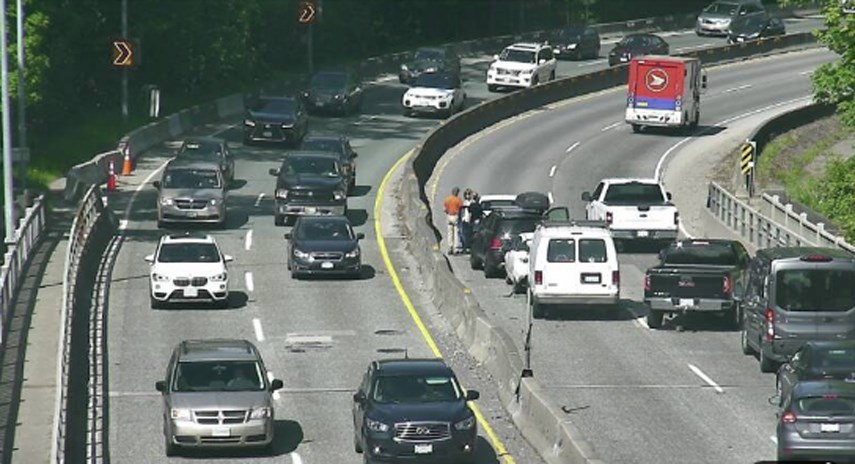Bus routes on the shoulders, twinning the Capilano River Bridge and more bicycle infrastructure – the province is eyeing significant changes to Highway 1/99 through the North Shore.
The Ministry of Transportation and Infrastructure released a report Friday (Feb. 11), assessing challenges the North Shore’s highway corridor will face as it becomes much busier between now and 2050, and what can be done about it.
“The Upper Levels Highway’s obviously very important for people and goods movement throughout the North Shore and it has largely remained unstudied since the 1990s,” said Bowinn Ma, Minister of State for Infrastructure and NDP MLA for North Vancouver-Lonsdale. “[This] provides all of us in government with a road map for a range of co-ordinated, multi-modal highway network improvements.”
Unlike previous studies, this one attempts to look at the highway as transportation infrastructure more holistically, Ma said. That means less emphasis on the single-occupancy vehicle and more emphasis on more socially and environmentally responsible modes like cycling and transit.
The study found 16 potential improvements over the short, medium and long term, all of which should make the route safer, more efficient and give people more options for getting around.
Within the next five years, the province and municipalities could work on more minor interchange improvements, including extending some on- and off-ramps, add cycling improvements to most interchanges and replace the current Pemberton Avenue pedestrian overpass with a multi-modal one, and add a new active transportation route between Westview Drive and Pemberton,
In the medium term (five-plus years), the report suggests building a St. Georges Avenue overpass for cars, bikes and pedestrians, improving active transportation infrastructure at the Lonsdale overpass, and extending the eastbound off-ramp for Lynn Valley Road.
And over the longer term, the province and TransLink could introduce a new bus service that travels on the highway shoulders, the report suggests, and the province could twin the Capilano River Bridge.
The report does consider adding general purpose lanes, but it also warns that traffic flow is constrained mainly by the bridgeheads, meaning more capacity on the Upper Levels won’t speed up overall travel time.
“Our transportation challenges won't be solved by tripling or quadrupling the size of this highway. It's far more complex than that,” Ma said. “And we know that doing that would likely only drive more people into their cars, and more cars travelling around the North Shore is bad for everybody.”
When it comes to safety, the report notes collisions at the Capilano Road interchange are by far the most common, followed Lynn Valley Road, Westview and Lonsdale. Crashes primarily happen to those who are driving eastbound.
The report also acknowledges that the North Shore continues to grow as a job centre but, because of housing unaffordability, it is increasingly reliant on importing workers from places farther afield. The modelling predicts trips on the corridor within the North Shore will grow between 20 and 45 per cent in the coming years.
“It's creating a heck of a lot of travel,” Ma said. “I would say there's some stark warnings about transportation in the future of the North Shore if we don't do something differently.”
Ma said a major key to avoiding a transportation morass worse than we have already is also within the three municipal halls, where councils should be concentrating housing near jobs and services so that people aren’t reliant on the highway for everything they need.
If the North Shore is successful in its bid to bring rapid transit across Burrard Inlet, that would be a game changer, Ma added.
Although the report focuses on the highway west of Lynn Valley, it also acknowledges that, without improvements, travel conditions on the eastern stretch “will continue to degrade.”
The $200-million Lower Lynn Improvement Project is now complete but commuters and residents have noticed it continues to back up most evenings. Ma said that underscores the need to pursue other options.
“It does offer significant safety improvement, and flow improvements as well,” Ma said. “But if people are expecting that that project is going to solve traffic and congestion on the North Shore all on its own, it definitely won't – and I've been actually quite consistent about pointing that out.”



